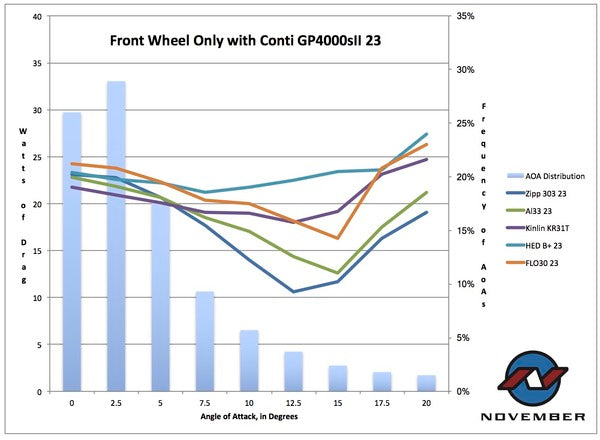This blog, and series, will be a way more difficult story to tell than I'd thought it would be.
What we'd expected was that the Zipp 303 reference wheel would be that shade faster at the heavily prevalent and thus more important narrow angles of attack (aka yaw angles), and then extend that lead out into the angles that occur with much less frequency. What actually happened was that the Al33 (our RFSW3 wheelset's rim) and the Kinlin XR31T (that we use in the FSW3) both performed better than the 303 at the most prevalent low yaw angles, starting to cede a bit at around 7.5* and going on from there.
When you do a test like this, you get a lot of data, and it takes a while to chew and digest it. What we present here is just a first, very broad, pass at things.
The blue vertical bars that you see in the graph are the amount of time the average cyclist is likely to spend encountering each wind angle during a ride. We will offer a very complete explanation of that in the next blog.
For now, we're just trying to wrap our heads around this, and make good on all the teasing that we've done. Sorry for that, hope it was worth it.
Enjoy


20 comments
Custom is going up momentarily, and don't get paralisized too badly – we sold out half of our first order in 3 days. It will surprise us none if this round is gone by Friday or sooner.
Thanks for all the info. Now I have to work through my analysis paralysis to decide where I want my wheels to land in the spectrum of weight, aerodynamics, and cost. :)I see the RFSW is now available for pre-order, but the Custom Al33 is not. Is that intentional?
No, don't make that comparison. First Rail test was a different tire – some kind of Vittoria we loved riding on at the time. It was before the whole testing paradigm had gelled around the Conti GP4000. The best comparison I can do is that the Tour Magazin test from last fall (2016) gives a 3w edge to the 404 from the 303. When we do the final calc from the whole distribution and make the "one number of seconds gained or lost in the mythical 40k TT" it will show the 303 ahead of the other two by some fraction of a second. So if 3w = 9 seconds, and we called the 404 2 seconds faster than the 52, you're at the Rail being 7 seconds faster than this group, and about 13 seconds faster than a Belgium+. When things go kind of not the way you expected like this, one of the challenges is learning exactly what it is you've learned. And I'm going to repackage a sentiment expressed by Tour in their test here – once you have a competent wheel as a minimum, your room for gains over that is limited. You might even call it… marginal. But of course as always it matters what problem you are solving, and there are as many of those as hairs on my head (which fortunately still means that there are lots of them).
Dave,This is sort of an odd one, but its been so long since I have read the data on it. Where would an original Rail52 fit on this plot, just so I could use it as a frame of reference. If I remember correctly, they were around 24 watts of drag at a 2.5* AOA, so is this chart saying that at 2.5* AOA the XR31T and AL33 are faster than the rail?
You guys are the fucking best. And you continue to set the standard for general wheel tech bloggage content. Thanks.-J